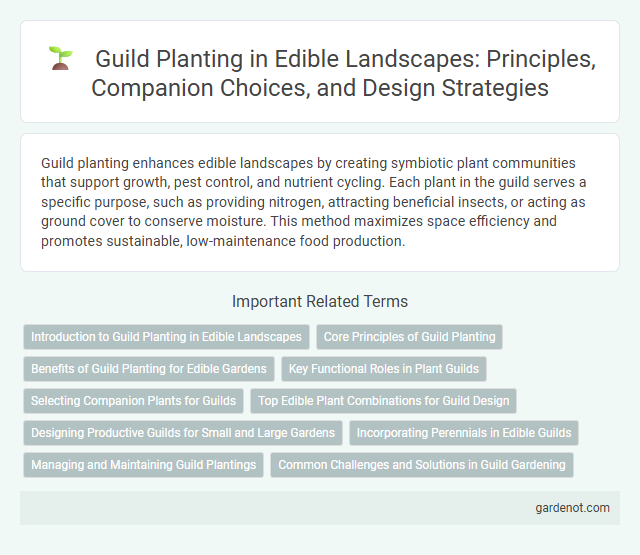Guild planting enhances edible landscapes by creating symbiotic plant communities that support growth, pest control, and nutrient cycling. Each plant in the guild serves a specific purpose, such as providing nitrogen, attracting beneficial insects, or acting as ground cover to conserve moisture. This method maximizes space efficiency and promotes sustainable, low-maintenance food production.
Introduction to Guild Planting in Edible Landscapes
Guild planting in edible landscapes integrates complementary plants that support each other's growth, nutrient cycles, and pest control, creating a sustainable and productive ecosystem. This method combines fruit trees or shrubs with nitrogen-fixing plants, ground covers, and pollinator attractors to enhance soil fertility and biodiversity. Implementing guilds maximizes yields, reduces maintenance, and promotes resilience against environmental stresses and pests in edible garden designs.
Core Principles of Guild Planting
Guild planting centers on creating synergistic plant communities that support each other through complementary functions such as nutrient cycling, pest control, and pollination enhancement. Core principles include selecting diverse species that fulfill distinct ecological roles--such as nitrogen-fixing plants, dynamic accumulators, ground covers, and pollinator attractors--to establish resilience and improve soil health. This holistic approach maximizes productivity and sustainability within edible landscapes by mimicking natural ecosystems.
Benefits of Guild Planting for Edible Gardens
Guild planting enhances edible gardens by creating diverse plant communities that improve soil health, reduce pests, and increase yields. Companion plants in a guild fix nitrogen, attract pollinators, and provide natural pest control, leading to healthier, more resilient crops. This symbiotic approach maximizes space and resources, fostering sustainable, productive garden ecosystems.
Key Functional Roles in Plant Guilds
Key functional roles in plant guilds include nitrogen fixation, nutrient accumulation, soil conditioning, and pest management, essential for a thriving edible landscape. Nitrogen-fixing plants like clover enrich soil fertility by converting atmospheric nitrogen into a usable form for surrounding plants. Dynamic accumulators such as comfrey mine deep soil nutrients, while pest-repellent species like marigold protect the guild from harmful insects, promoting plant health and productivity.
Selecting Companion Plants for Guilds
Selecting companion plants for guild planting in edible landscapes optimizes growth, pest control, and nutrient cycling. Key species include nitrogen-fixing legumes like clover or beans to enrich soil fertility, dynamic accumulators such as comfrey that mine deep nutrients, and insectary plants like yarrow or dill to attract beneficial pollinators and predators. Strategic layering of fruit trees, shrubs, ground covers, and herbs fosters a resilient, self-sustaining ecosystem that maximizes yield and biodiversity.
Top Edible Plant Combinations for Guild Design
Guild planting thrives on complementary relationships among plants, optimizing growth and yield in edible landscapes. Top edible plant combinations for guild design often include nitrogen-fixing species like clover, dynamic accumulators such as comfrey, and fruit-producing plants like apple or hazelnut trees to enhance soil fertility and pest control. Incorporating herbs like chives and marigold further supports pollinators while deterring pests, creating a resilient and productive ecosystem.
Designing Productive Guilds for Small and Large Gardens
Designing productive guilds for small and large gardens involves combining complementary plants that support each other's growth, such as nitrogen-fixing legumes, nutrient accumulators, and pest-repellent species. Strategic layering of canopy trees, shrubs, ground covers, and root crops maximizes space utilization and improves soil health within edible landscapes. Tailoring guild composition to local climate and soil conditions enhances biodiversity and yields sustainable food production year-round.
Incorporating Perennials in Edible Guilds
Incorporating perennials in edible guilds enhances biodiversity and soil health while providing consistent yields year after year. Perennials such as berry bushes, herbs, and nut trees establish strong root systems that improve water retention and nutrient cycling in the landscape. These plants also attract beneficial insects and pollinators, creating a resilient ecosystem that supports sustainable food production.
Managing and Maintaining Guild Plantings
Managing and maintaining guild plantings involves careful monitoring of plant health, soil moisture, and nutrient levels to ensure sustainable growth within the edible landscape. Regular pruning, mulching, and companion planting are essential techniques to suppress weeds, enhance biodiversity, and promote beneficial insect activity. Implementing integrated pest management and periodic soil testing supports long-term productivity and resilience of guild systems.
Common Challenges and Solutions in Guild Gardening
Common challenges in guild planting include competition for resources, pest management, and soil nutrient depletion. Implementing companion planting strategies and selecting complementary plant species can reduce competition and improve pest resistance. Regular soil testing and organic mulching enhance nutrient availability and overall guild health.
Guild planting Infographic

 gardenot.com
gardenot.com